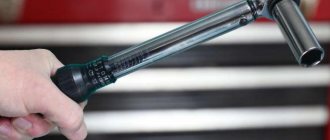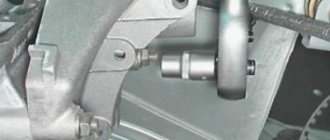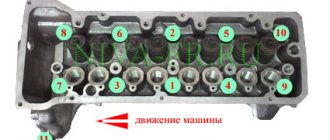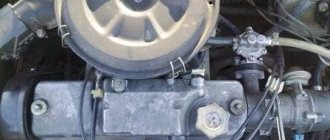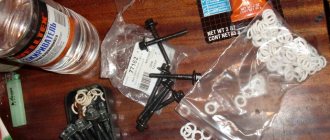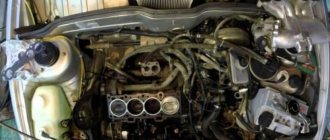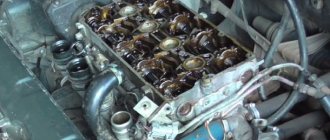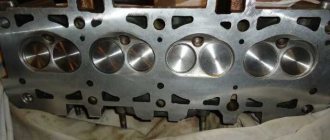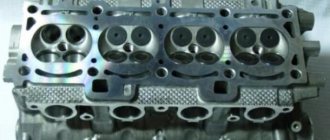I encountered the following problem: I replaced the piston with a plugless automatic transmission. The diesel is gone. But on a hot engine, a knock appeared, which directly depends on warming up. The feeling is that the block is moving away and the piston-cylinder gap is coming out (during installation I made 3 hundred parts). So the essence of the issue is that there are two tightening methods that I came across in the literature, 1st - a torque of 20 N m (2 kgf m); 2nd - torque 69.4–85.7 N m (7.1–8.7 kgf m); 3rd - tighten the bolts 90°; 4th - finally tighten the bolts 90°. or Using a torque wrench, tighten the head mounting bolts in three steps - first with a torque of 20 N m (2 kgf m), then turn the bolts by 90° and then turn the bolts again by 90°. I pulled the first one myself. Is the question correct? If you have links to sources, please share.
Comments 51
In the official VAZ technological instructions for the repair of TI 3100 engines. 25100.40157 on page 49 it is written that the bolts on engines 2112, 21124, 21126 and 11194 must be tightened in 4 steps: 1. Tightening with a torque of 12...20 Nm; 2. Tightening torque 26…34 Nm; 3. Turn 90 degrees; 4. Turn 90 degrees.
Here are the differences in the gaskets given for the motors, for metal there is one method, for paranitum another. All that remains is to find out which example is for what.
There are no differences for these motors, regardless of the gasket. There is a difference for motors of the “classic” family: if the gasket is shrinkable, then bolts 2101 are used and tightened in 2 steps, if non-shrinkable, then bolts 21213 and tightened in 4 steps. For 16-valve engines, only non-shrink gaskets are used and the tightening torque is the same for them - in 4 steps, as indicated in my comment.
Then what is the difference? The two books are different methods. There are still suspicions about a fake author, although how can you put it into circulation with obviously incorrect information. Maybe this is the case, for example, for 8th grade and 16th grade?in general, it’s a mystery.
What two books? I am guided by the official VAZ technological instructions. The bolts for 8 and 16 valve engines are different: M12x1.25 - for 8-valve engines. M10x1.25 - for 16 valves. The length of the bolts also varies. It is possible that the material is different. Also, the load on the joint is different for 8 and 16 valves. As for classic motors, the bolts and their tightening torque depend on which gasket is used - shrink or non-shrink. Manuals from various publishers, as well as advice on tightening from home-grown masters who say that “with your hands you feel that you are stretching” (in fact, with your hands you can only feel a woman’s ass or your own pussy and everything like that) should be treated with caution, I wouldn't listen to the latter at all. In the manuals for tens and Prioras from Za Rulem, for example, I saw recommendations for tightening the cylinder head bolts in the form of 20 Nxm + 90 deg + 90 deg, which is incorrect - such a connection will soon be weakened.
I'm sorry for the stupid question, can you share the link to the official manual? The search request contains 10 pages of dubious sites, not a single link to the official source.
There is no link, but the technological instructions themselves are there. Send me a private email and I’ll send it to you.
What two books? I am guided by the official VAZ technological instructions. The bolts for 8 and 16 valve engines are different: M12x1.25 - for 8-valve engines. M10x1.25 - for 16 valves. The length of the bolts also varies. It is possible that the material is different. Also, the load on the joint is different for 8 and 16 valves. As for classic motors, the bolts and their tightening torque depend on which gasket is used - shrink or non-shrink. Manuals from various publishers, as well as advice on tightening from home-grown masters who say that “with your hands you feel that you are stretching” (in fact, with your hands you can only feel a woman’s ass or your own pussy and everything like that) should be treated with caution, I wouldn't listen to the latter at all. In the manuals for tens and Prioras from Za Rulem, for example, I saw recommendations for tightening the cylinder head bolts in the form of 20 Nxm + 90 deg + 90 deg, which is incorrect - such a connection will soon be weakened.
Adjusting the tightening torque of bolts for a 16 valve car
Adjusting the tightening torque is a simple process, and after reading the material and video in this article, you can handle it yourself. It is enough to tighten it once and then you will be able to do it yourself and at the same time you will be able to help your friends if necessary. It is important to adhere to the diagram for cars with a 19-valve engine and observe the timing.
Required Tools
- knob;
- rod compass;
Scheme
The pattern for tightening on a 16-valve engine differs from the pattern for an 8-valve engine, so we will present both one and the other so that you can compare them.
Diagram for 16 valves Diagram for 8 valves
Just don't get confused when you install. In any case, before starting work, check the instructions that came with the car. Tightening with different torques on a 16 valve unit occurs in 2 circles with different torques, and then another 2 circles with a rotation of 90 degrees. Nothing is difficult, which means you can cope on your own.
Stages
In order for self-tightening of bolts to be completed successfully and to last for a long time, a number of simple rules should be followed:
- It is better to use new bolts, since during operation they are under constant tension and lose their properties over time. There is no guarantee that the old bolt will not withstand the stress and will burst.
The length should not be more than 9.5 cm
- It is not advisable to reinstall the gasket, even if it is in reasonable condition.
- Strictly observe torque when tightening.
- The sequence of tightening the bolts should be exactly the same as in the diagram for 16-valve power plants.
- Before installing the cylinder head, carefully inspect all parts for damage and deformation. If any are found, do not ignore them, but be sure to replace them. Often, small breakdowns lead to major damage, and sometimes even to the complete destruction of systems and mechanisms.
- Do not use tools of dubious quality and manufacture. This is especially true for a torque wrench.
- 1st circle - moment 20 N m (2 kgf/m);
- 2nd circle - moment 69.4–85.7 N·m (7.1–8.7 kgf·m);
- 3rd circle - turn the bolts 90 degrees;
- 4th circle - another 90 degree turn.
By following these simple rules, you can guarantee the best tightening and a reliable tight connection.
Place the cylinder head on the block, first making sure that the crankshafts and camshafts are set to the top dead center (TDC) position.
The tightening process itself takes place in 4 circles:
As you can see, everything is simple. If you have any questions, watch the video. In terms of time, this work does not take more than twenty minutes, but it allows you to save a decent amount, which they will charge you at the service station.
Let's move on to the cylinder block
We remove the pallet. Rotating the crankshaft as it is convenient for us, unscrew two bolts on each connecting rod cap. We use a TORX E10 head for this.
We take out the pistons along with the connecting rods. To do this, use the wooden handle of a hammer to press the connecting rod from below and lightly tap it to knock it up. We remove the old liners and buy new ones of the same size according to the markings on them. Here is another stone in AvtoVAZ’s garden, the owner has never climbed into the car from the interior or into the engine, but three pistons were of group “B” and one was “C”. It turns out that at the factory they re-sharpened one cylinder a little and simply put an enlarged piston there, no words. There are no options, we take group “C”, don’t sharpen the engine because of this. We will not touch the main liners either.
We buy a new piston group that does not bend the valves, connecting rods and connecting rod bearings.
Eliminating longitudinal play of the crankshaft
It was noticed on this motor. To eliminate it, replace the thrust half-rings. Standard and repair sizes are available. We take the first repair size, if they are too tight we sand them down a little. We unscrew the middle main bearing and gently push it with a screwdriver and move the half rings. The mark on it is in the form of three serifs, shown below.
When the half ring comes out a little, turn the crankshaft, it will push it out. There are two types of half rings: white at the front and yellow at the rear; the grooves on them should point towards the crankshaft cheeks.
We install them as we removed the new half rings; if they go in with great effort, you can grind them a little on a small abrasive stone, but not from the side of the grooves. Checking the play. We tighten the main bearing with a torque of 8 kgf*m.
Assembling the piston
There is an arrow stamped on the top of the piston; it should be directed towards the front of the engine. And there are marks on the connecting rod that should look the same way. Don't get confused!
We insert one retaining ring into the groove on the piston. We insert the connecting rod into the piston and, having lubricated the connecting rod and the piston pin with oil, insert it into place. Insert the second retaining ring. Although this operation seems simple, it will take some pains. We inspect the assembled structure; all retaining rings must be clearly in their grooves, otherwise a ring that has jumped out while the engine is running can cause a lot of trouble.
After assembly, you need to break off the connecting rod bearing cap, since the connecting rod is made in one piece. It's like that on our cars. First, unscrew the bolts. We insert the connecting rod into the cleats at the level of the mark shown in the figure with the black arrow and lightly clamp it, then break it off with a slight movement of the hand. The first time is very scary. We put the cover in place and tighten the bolts so as not to mix it up in the future.
Checking the thermal gap in the piston rings
We lay out each set of rings for each cylinder. In the future we will not change their places. In turn, we insert each ring into its own cylinder and push it a little with the piston approximately to the middle.
Nominal clearance: 0.25 - 0.45 mm.
The maximum clearance for all is 1 mm. But this already smacks of waste.
Installing new rings
First, install the oil scraper ring expansion spring, then the ring itself. The oil scraper ring lock should face the opposite direction of the spring lock. Then we install the lower compression ring and finally the upper compression ring. The inscription “TOP” must be stamped on the rings; it must face up. The rings in the piston grooves must rotate easily.
Tightening torque for cylinder head VAZ 21126
Many owners of a Lada Priora with engine 21126 16 valves, in the process of servicing and repairing the car, independently replace the head gasket or grind the valves. When performing such work, it is important to observe the sequence and tightening torque of the cylinder head on the Priora. During the operation of any car, including the VAZ 2170 Priora, the engine head is exposed to long-term cyclic effects of gases located in the engine cylinders. On older power units, the tightening of the cylinder head screws could weaken under such loads and periodically needed to be brought to a normal level. Today, all VAZ Priora engines use bolts made of special steel, which are tightened once for their entire service life. If a coolant and oil leak occurs, there is no point in further tightening and tightening these bolts, since this will not improve the tightness of the joint. The only correct way to combat a leak is to remove the head, check the evenness of the mating surfaces and replace the gasket. After performing any repair work related to removing the head from the engine, it must be tightened in compliance with all necessary conditions. Here you also need to know that the tightening sequence on 16 cl and 8 cl units is different, so you need to be careful. The torque on the 16 and 8 valve power units is the same and passes in four circles.
How to change the cylinder head gasket on a Priora
You can often hear from old drivers: “Well, the water has gone into the house!” An inexperienced car enthusiast will begin to examine the rugs in surprise, glancing suspiciously at the area of the stove, or will simply look in bewilderment at the person who said it.
What's the matter? The fact is that they say so when coolant gets into the oil pan. The reason for this, most often, is a burnt-out cylinder head gasket.
What it is and how to fix this problem at Priora is written below.
Signs of a burned out cylinder head gasket
This usually happens in the areas between the cylinders. This is the thinnest part of the gasket. And the degree of damage varies. Also, signs that the gasket requires replacement depend on which of the channels in the block wall is damaged:
- Oil.
- Cooling systems.
- Both at once.
If the oil channel is damaged, engine oil will begin to enter the working cylinder. This will cause rapid oiling and failure of the spark plug. Misfires appear. The engine "troits". This sign is, in general, common to all options. Oil consumption increases.
If there is a breakdown in the cooling system, then with minimal engine heating, the coolant in the expansion tank bubbles. The impression is that the engine is “boiling”, although the temperature is normal.
There is a copious flow of condensate from the exhaust, with the smell of coolant. Well, damage to two channels on the Priora leads to liquid getting into the oil pan. The oil turns gray and bubbly. This is immediately visible on the oil level dipstick.
Compression in the cylinders of the Priora engine also drops.
The Priora cylinder head gasket is made of special paronite and metal. When purchasing a replacement from a store, you should carefully check the part for cracks and breaks. Unfortunately, such defects are not uncommon.
How to replace
This work is a serious type of repair. Therefore, you need to approach it carefully. After all, you will have to remove the cylinder head on the Priora. It takes place in several stages:
- Preparation of "Priora"
- Electrical shutdown.
- Removing the intake receiver.
- Removing the timing belt
- Removing the valve covers.
- Removing the cylinder head directly.
- Checking the condition of the head.
- Replacing the gasket.
- Reassemble in reverse order.
Preparation consists of checking everything necessary for this operation, keys, gaskets for replacement, sealant. Removing the decorative cover from the engine. Drain the coolant. Remove the throttle actuator and air pipe.
Then the battery is turned off, and the disconnection of the connectors of the sensors and actuators begins.
This is a sensor for throttle valve, camshaft position, oil pressure, idle air control, ignition coils and injectors.
The receiver is separated after unscrewing 2 10mm nuts in the upper part and 5 13mm nuts and bolts securing it to the cylinder head. Disconnecting and installing the timing belt is sufficiently described in many articles.
After removing the cover, unscrew the 10 cylinder head mounting bolts using a hexagon and remove it.
Important! Check the condition of the head for bending using a metal ruler. If there is the slightest suspicion that the head is “lost”, give it to a turner for grinding
Replace the gasket. Before installing a new one, apply a thin layer of special sealant to it. Reinstall and reassemble everything in reverse order.
When replacing the gasket, special attention must be paid to the order in which the head bolts are tightened.
The durability of the new Priora gasket installed as a replacement depends on proper tightening. You need to tighten starting from the center, and move crosswise to the edges. In different directions. Then the gasket installed to replace the burnt-out gasket will last a long time.
Next, a useful video about replacing the Priora cylinder head gasket:
Tools and materials
Before starting the tightening procedure, you should prepare everything necessary for the implementation: • a wrench with a built-in dynamometer up to 100 N/?m; • a set of heads and regular keys; • key Togh E14; • caliper for measuring the remaining length of bolts; • plate with a marked scale up to 180 degrees; • new bolts. In order to correctly tighten the cylinder head screws on a VAZ 21126: 1. Remove oil from the mating surfaces and check that there is no liquid in the bolt holes. 2. Install the gasket, center it and place the head on top. 3. Insert 10 mounting screws M10*1.25 into the guide holes, having previously lubricated the threads with engine oil. If you decide to use old bolts, which is permissible for 16 valve heads, then their remaining length should not exceed 98 mm. 4. Perform preliminary pulling according to the scheme with a torque of 12-20 N/m. 5. Increase the tightening degree to 26-34 N/m and re-pass all the bolts in the same sequence. 6. Then you need to tighten the screws 90 degrees, with a force of about 50 N/m. 7. Repeat tightening by 90 degrees again, the torque on the key will be approximately 80 N/m. Some instructions recommend waiting up to 20 minutes between turns, but in practice no advantages of such a scheme have been identified. 8. After assembling the power unit, you should check the quality of the work performed. The procedure for pulling the head on 1.8 liter engines, which are 1.6 liter engines with an enlarged cylinder, is completely identical to that described above. Briefly, 1st - torque 20 N m (2 kgf m); 2nd - torque 69.4–85.7 N m (7.1–8.7 kgf m); 3rd - tighten the bolts 90°; 4th - finally tighten the bolts 90°.
Let's start to disassemble
First drain the oil and antifreeze. We remove the protective cover, the air filter with hoses, and disconnect the connectors of the ignition coils, throttle cable and throttle assembly.
We remove the thermostat housing and at the same time disconnect all the connectors and hoses connecting them. We remove all the cables that were in our way towards the battery.
We remove the generator. We unscrew eight of the thirteen nuts holding the intake manifold and remove it. We unscrew all the bolts securing the valve cover, as well as the side engine support.
Unscrew the eight nuts and remove the exhaust manifold.
Remove the timing belt, camshaft pulleys and pump.
In three steps, so as not to deform the part, we first loosen and then unscrew twenty bolts of the camshaft bearing housing, head eight. Be sure to follow the sequence shown in the photo.
Remove the bearing housing. After removing the camshafts, there is a noticeable lip left on the intake camshaft.
Also, in several steps, we first loosen and then unscrew the ten head bolts. Be sure to follow the sequence shown in the photo.
Remove the cylinder head. All sixteen valves have been replaced.
Nuances of work
At different times, Lada Priora cars were equipped with engines with a displacement of 1.6 and 1.8 liters and a different number of valves in the heads - V8 (or 8V) and V16 (or 16V). The type of unit head determines the size of the bolts, the order of their installation and the tightening torque of the cylinder head on the Priora.
If the car has an 8-valve engine, then it can use head mounting bolts of different sizes:
- on old motors 21114, M12*1.25 hex head screws are used;
- on more modern 21116, which went into production approximately in mid-2011, M10*1.25 elements with an asterisk head are installed.
We change the cylinder head gasket on the Lada Priora ourselves
The cylinder head gasket must be replaced as soon as signs of its burnout are detected. Otherwise, it will negatively affect the operation of the engine. Changing the cylinder head gasket on a Lada Priora is not difficult. To do this, it is enough to have the necessary tools and follow the instructions for performing the replacement.
Why and when is the seal replaced?
The gasket acts as a seal, sealing the connection between the cylinder head and the cylinder block. It prevents mixing of working fluids. Therefore, high demands are placed on it. This is a disposable part that must be replaced in two cases:
- during any repair work accompanied by dismantling the cylinder head;
- if signs of burning or deformation are detected.
The need for replacement can be determined by the following characteristic signs:
- At the junction, smudges from antifreeze or motor lubricant are visible. The reason is often engine overheating, which leads to gasket deformation and burnout.
Engine assembly
We wipe the crankshaft journals, cylinder bores and connecting rod bearing seats with a clean rag; by the way, they can also be degreased. We put new liners into the connecting rod and the cover, so that the antennae of the liners fit into the grooves.
Lubricate the bearings, crankshaft journals and cylinders with clean oil. We unfold the piston rings with locks as shown in the figure, the angle between them should be 120 degrees.
We put a mandrel on the piston to compress the rings, having previously lubricated it inside with clean oil. Not forgetting about the direction, the arrow on the piston should be directed towards the front of the engine, we place it in its cylinder.
We turn the crankshaft so that the connecting rod journal is at the very bottom. Gently tapping the wooden handle of a hammer pushes the piston into the cylinder. We remove the mandrel and push the piston down until the connecting rod sits on the crankshaft. We put the connecting rod bearing cap on the bottom, remembering the marks. Tighten the connecting rod cover mounting bolts to a torque of 5 kgf*m. We also repeat with all the other cylinders.
We put back everything that we removed from below. We blow through the top and clean the holes for the cylinder head mounting bolts. We install a new cylinder head gasket and the head itself. Lubricate the bolts with a thin layer of oil, most importantly without fanaticism. We tighten the bolts in several passes in the reverse order of unscrewing, see photo at the beginning of the article. The tightening sequence is as follows:
- first tighten everything with a torque of 2 kgf*m
- then we tighten everything to a torque of 7 – 8 kgf*m
- turn it 90 degrees
- turn it 90 degrees again
We install hydraulic compensators, camshafts and camshaft bearing caps. Lubricate all rubbing surfaces with clean oil. Before installing the camshaft bearing caps, lubricate the perimeter and rims around the spark plug wells with a thin layer of sealant. We tighten the bearing cover bolts in the reverse order of unwinding, with a torque of 2 kgf*m, see photo at the beginning. Well, then we install all the parts in the reverse order of removal. We fill in all the fluids and start it, it may not start right away, this is normal. When you first start it will smoke well until the oil on the cylinders burns, make sure the oil pressure light goes out. Let it run for a minute and turn it off, and suddenly see where something is leaking. We start it several more times, constantly increasing the operating interval, bring it to operating temperature, constantly checking the oil and antifreeze, and also pay attention to the fact that no extraneous noise appears. Let it rest for an hour and then idle again for about an hour, constantly monitoring the temperature. Well, then the break-in, if you sharpened it, if not, then you can drive only the first thousand kilometers, try not to raise the speed above 3000, and not tow it.
